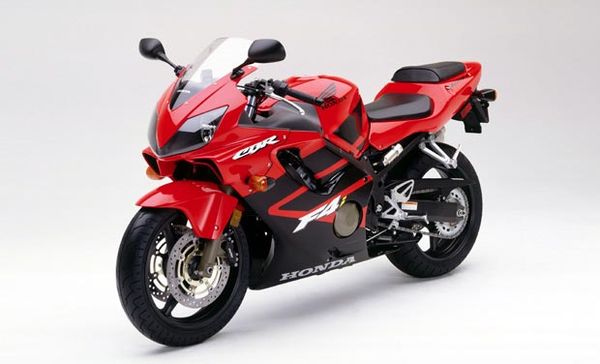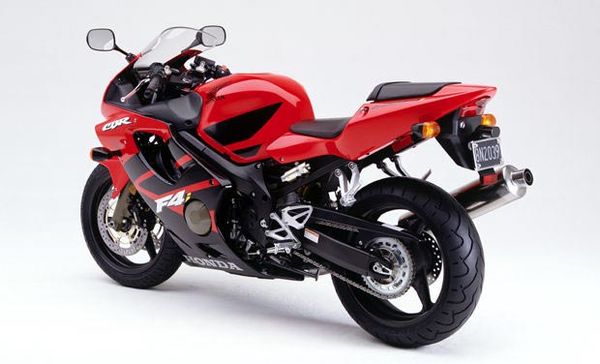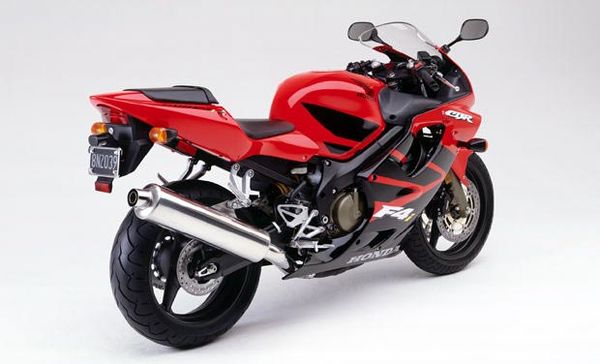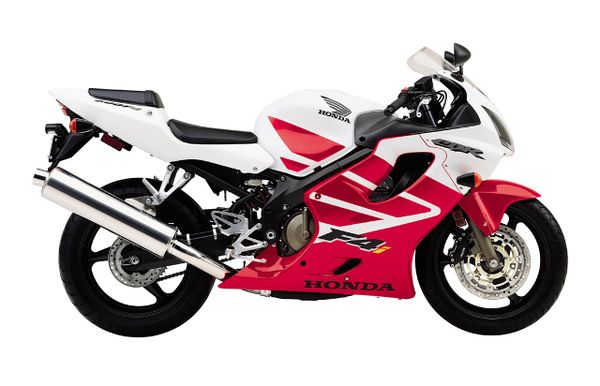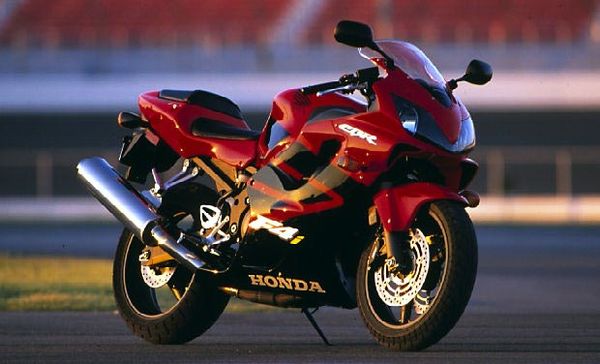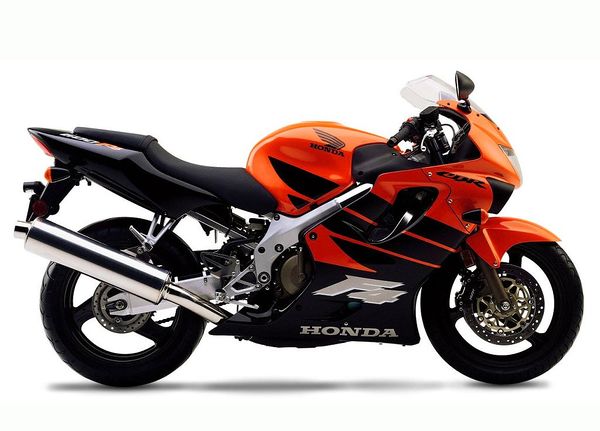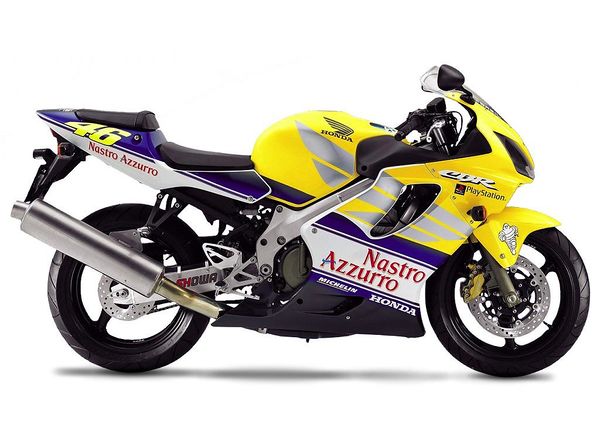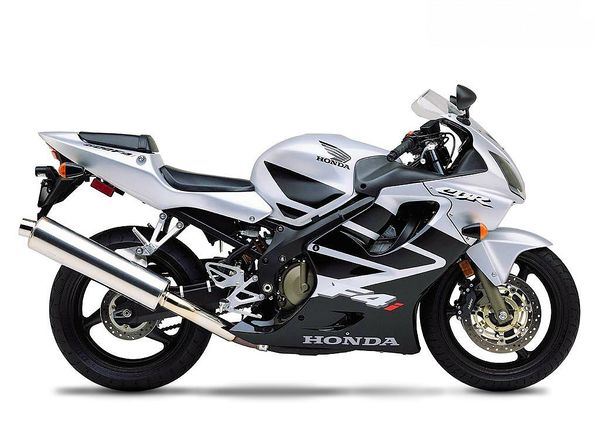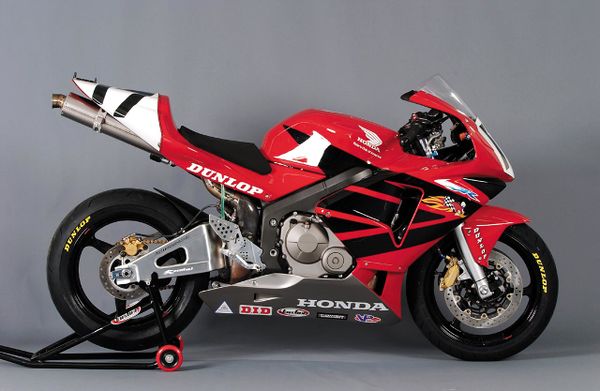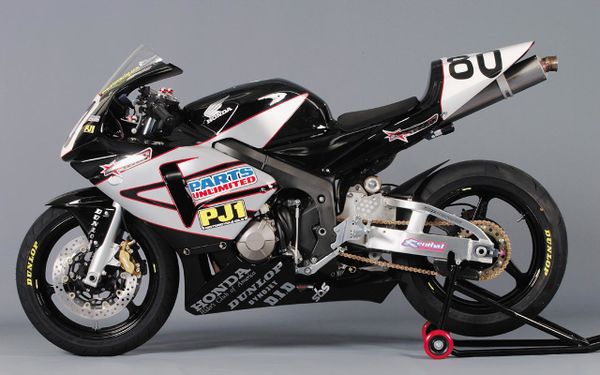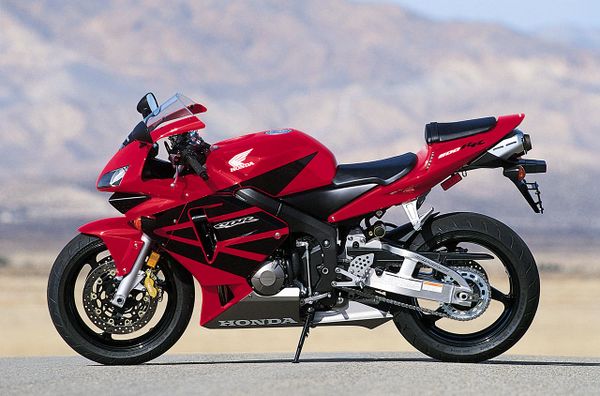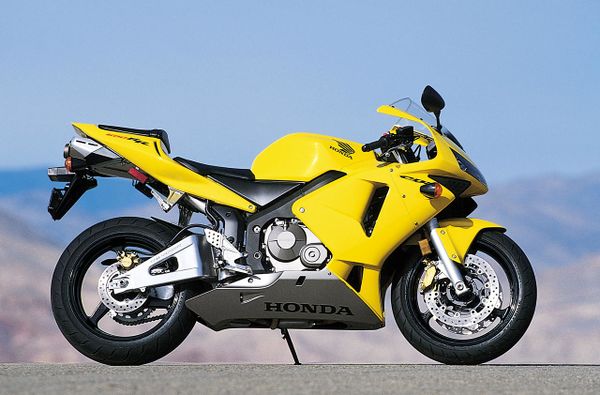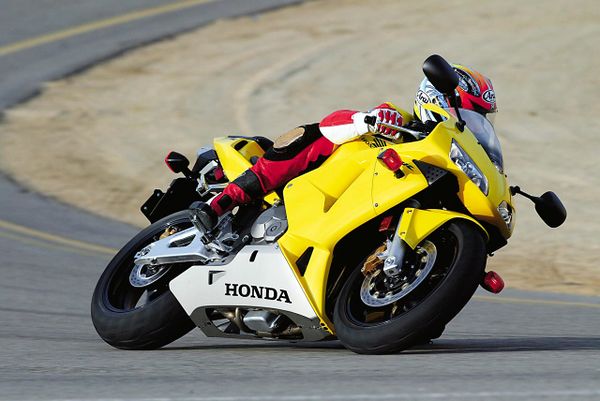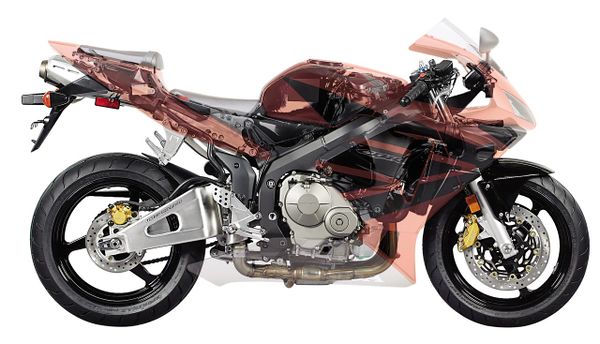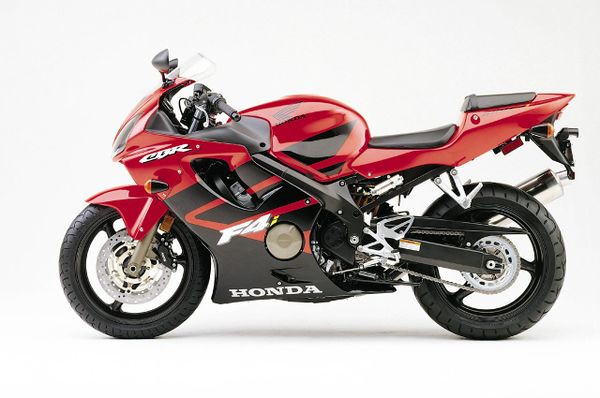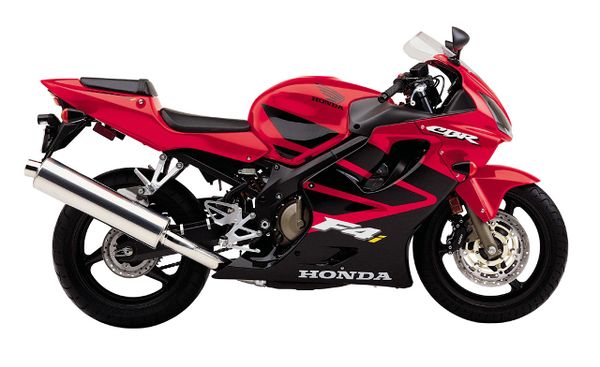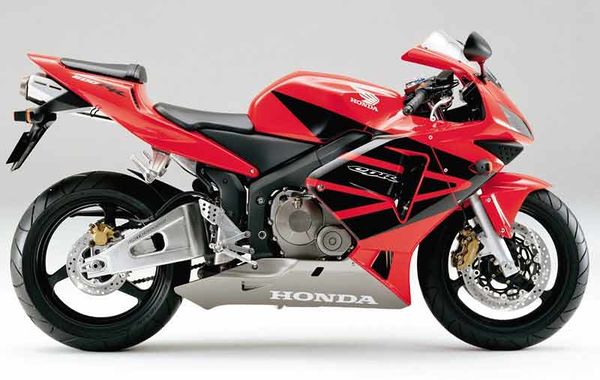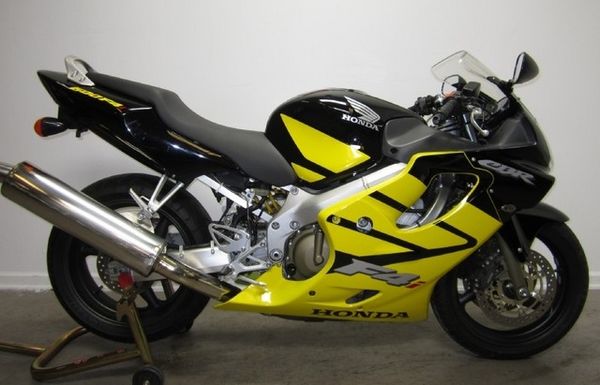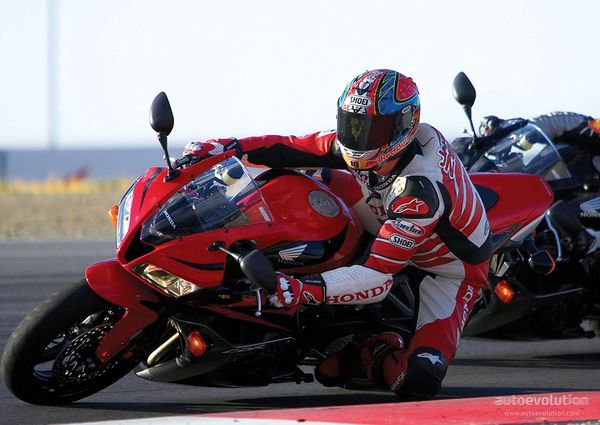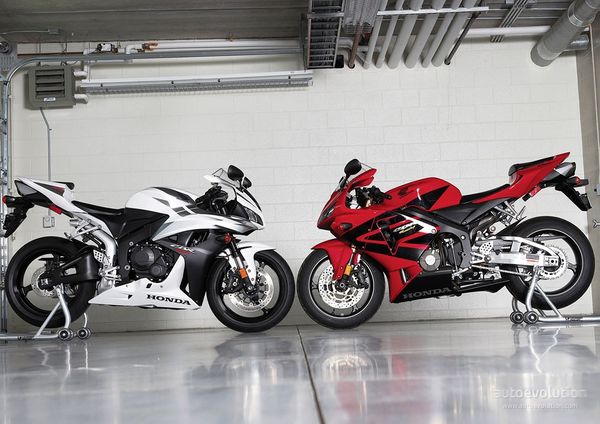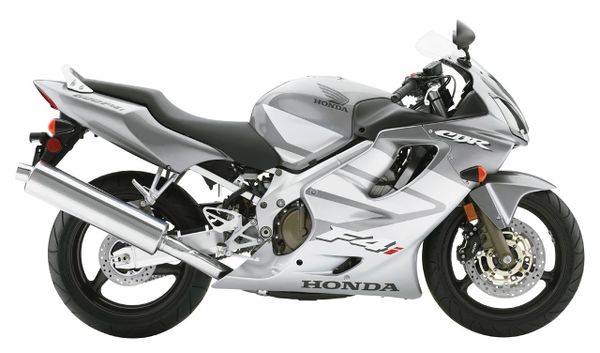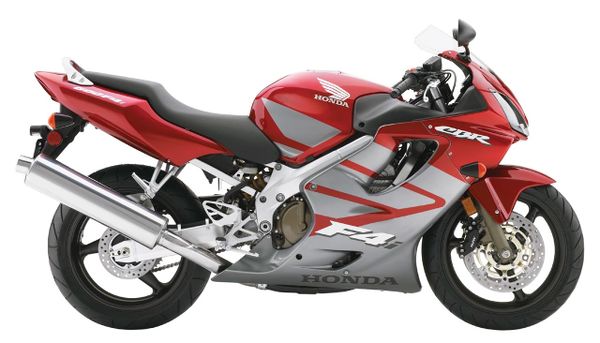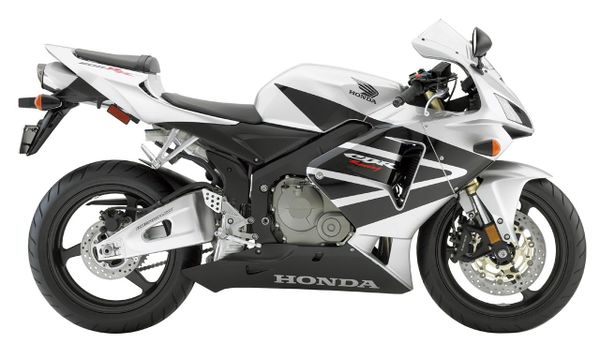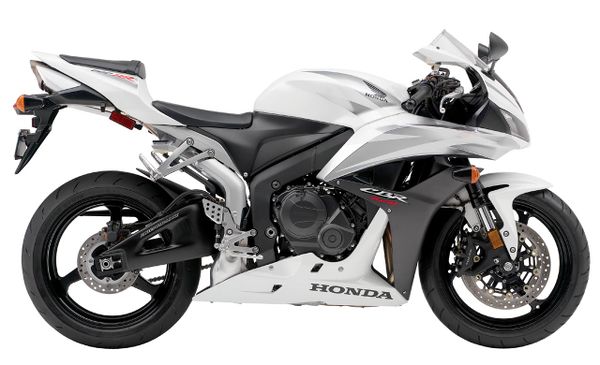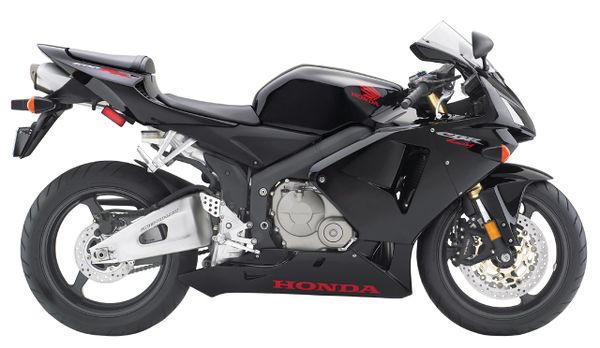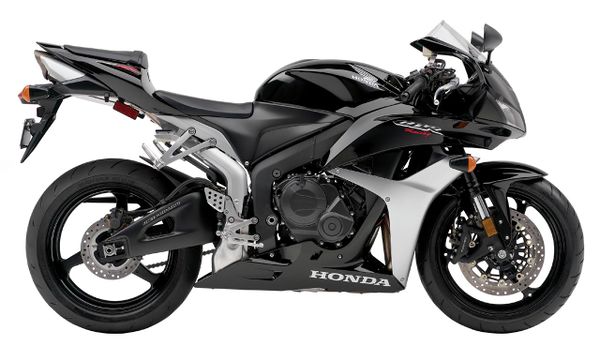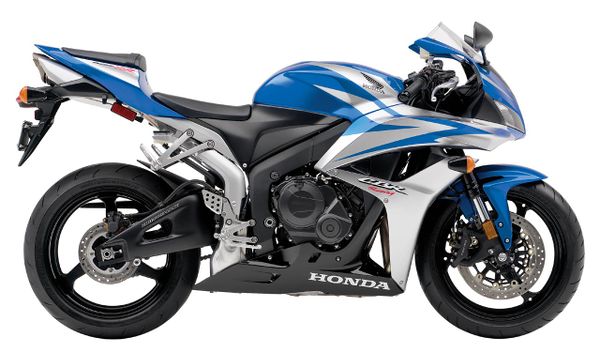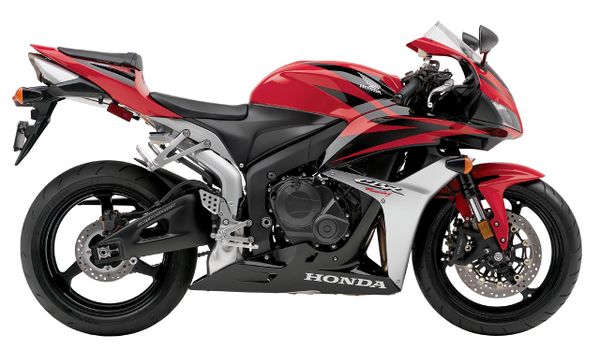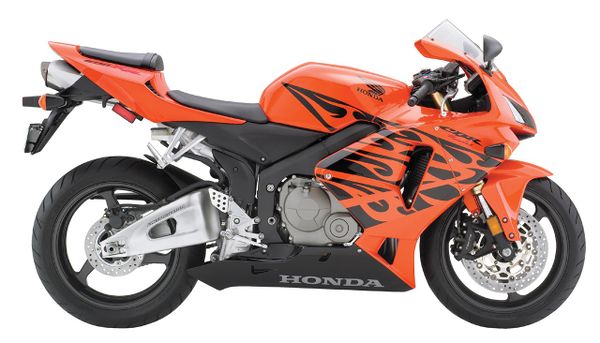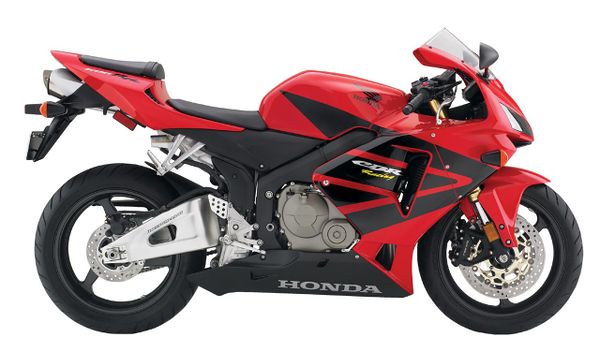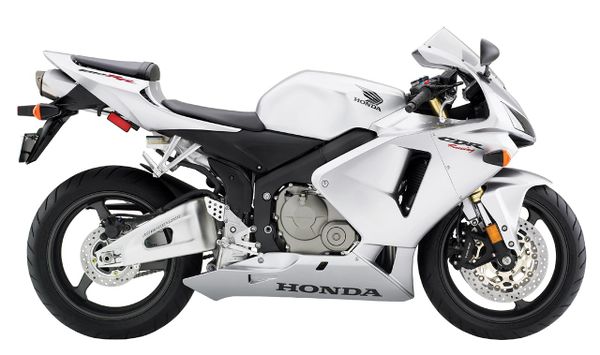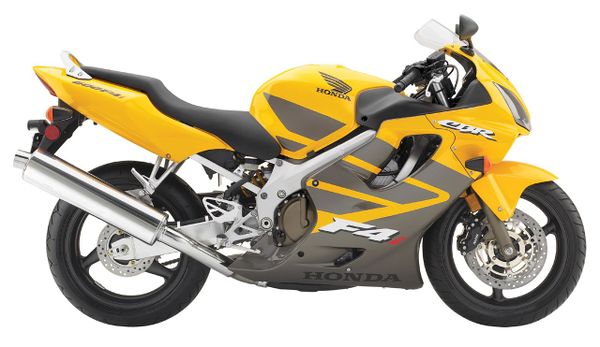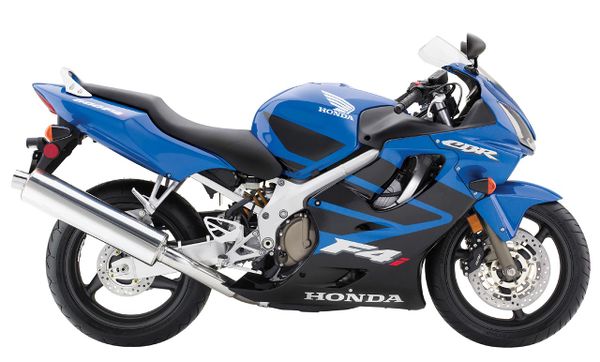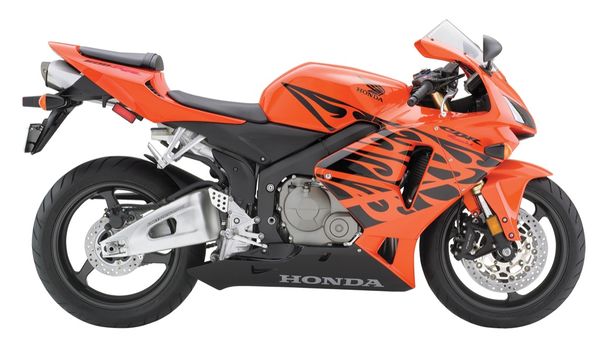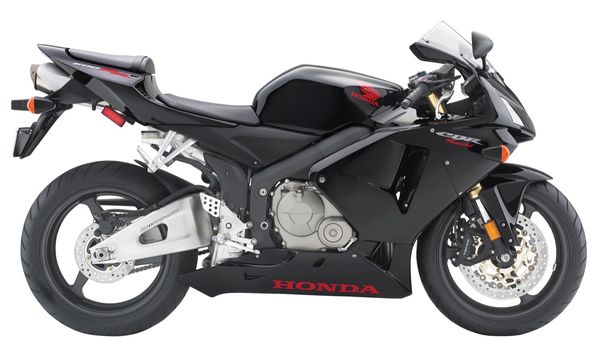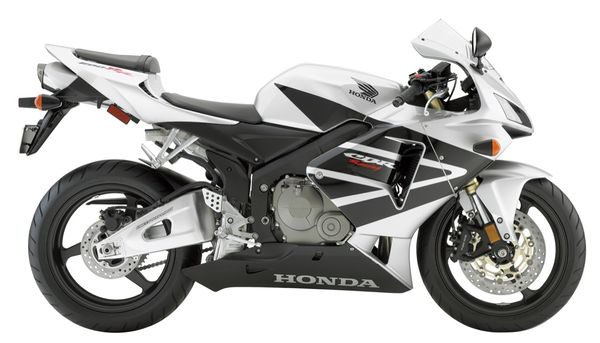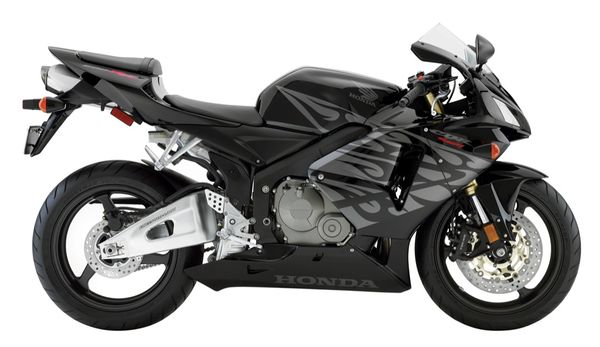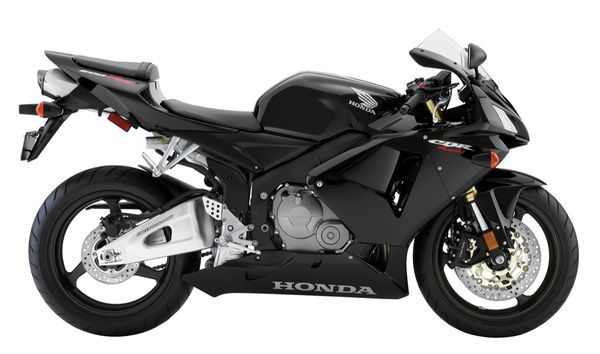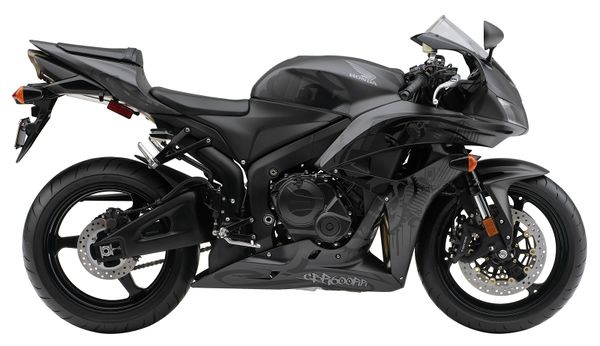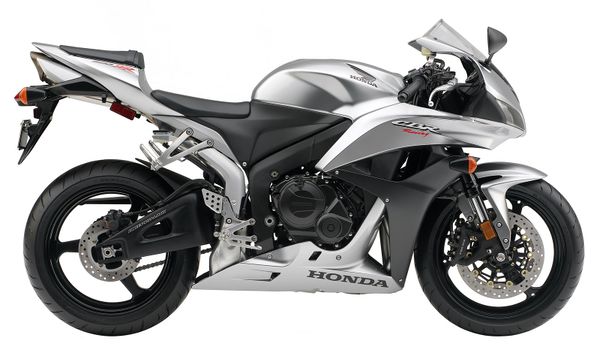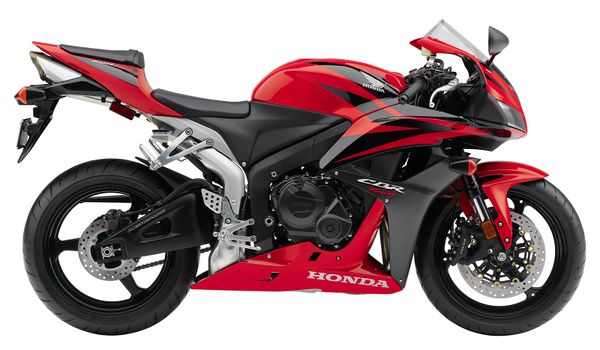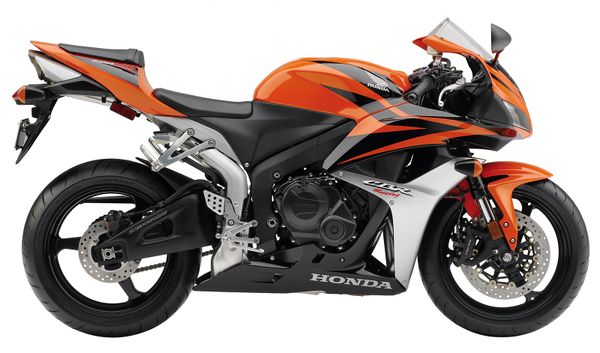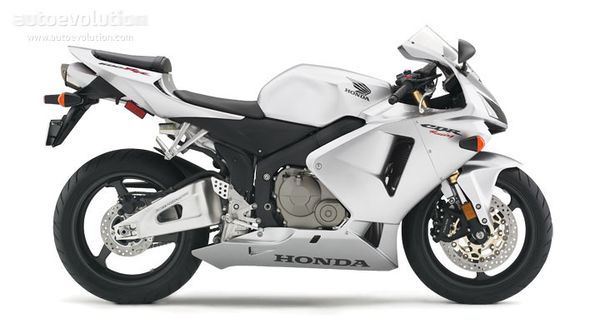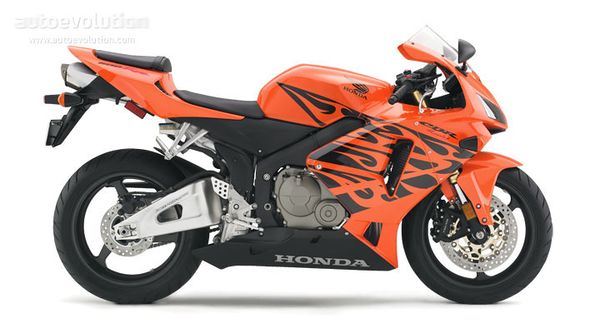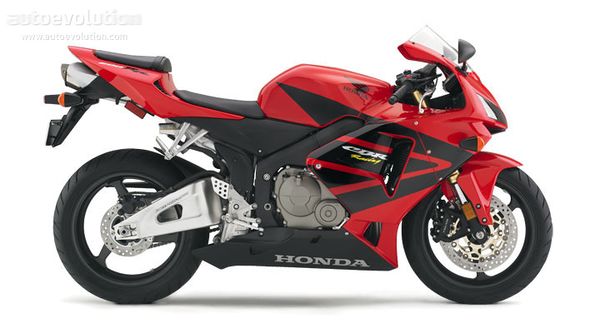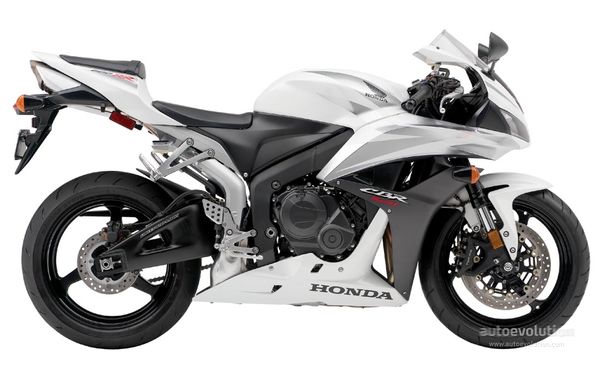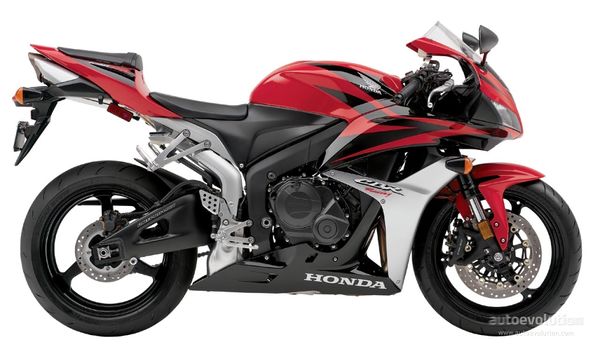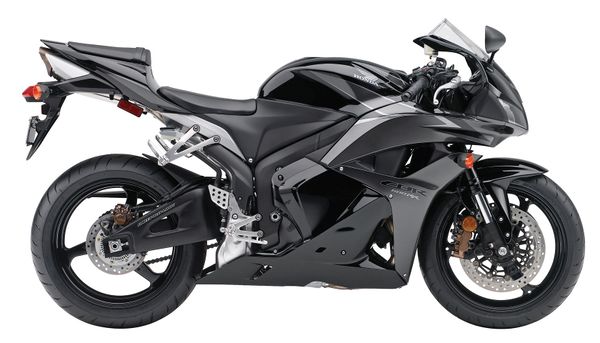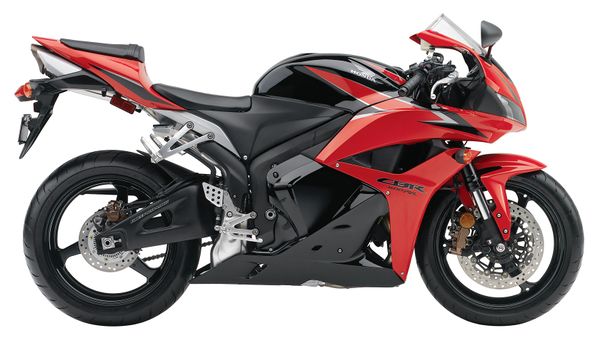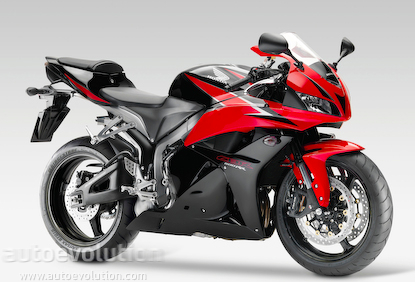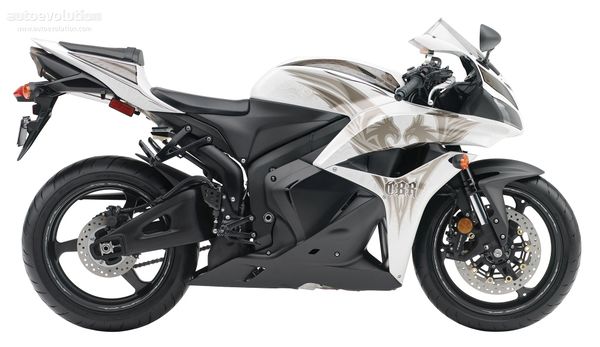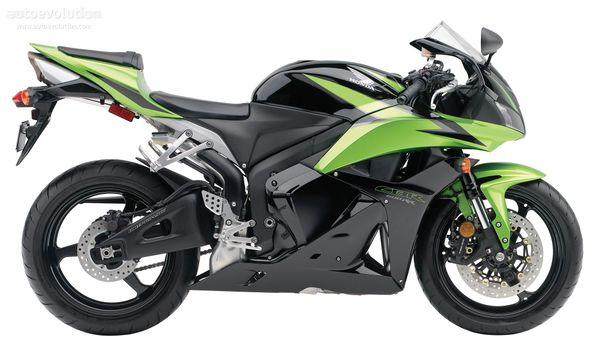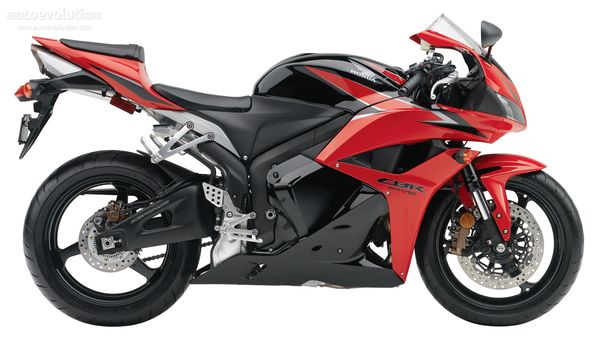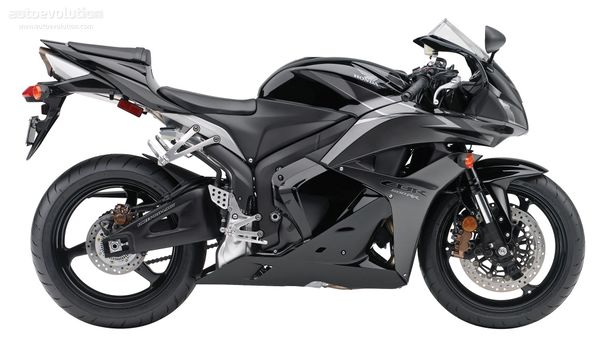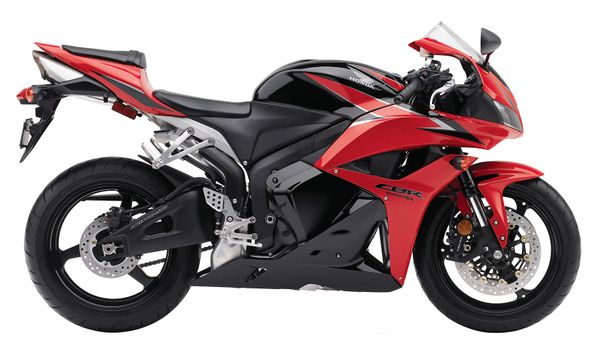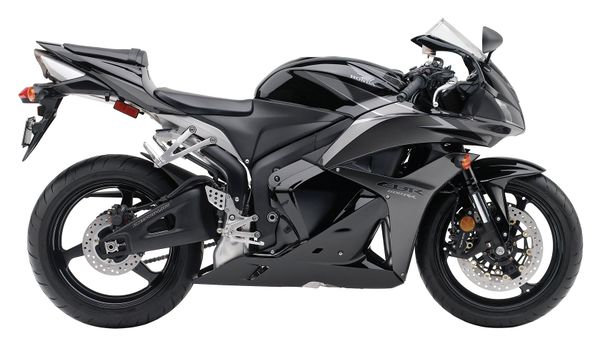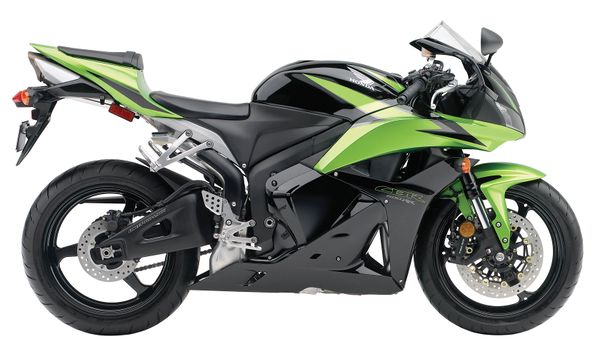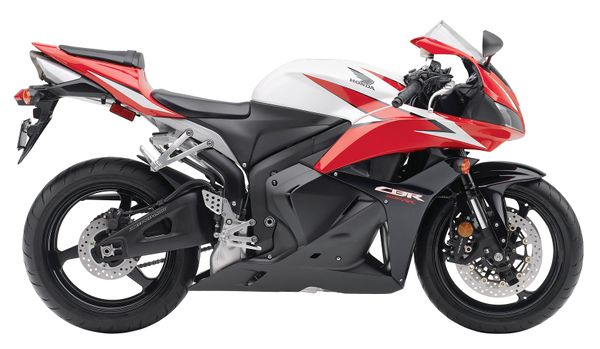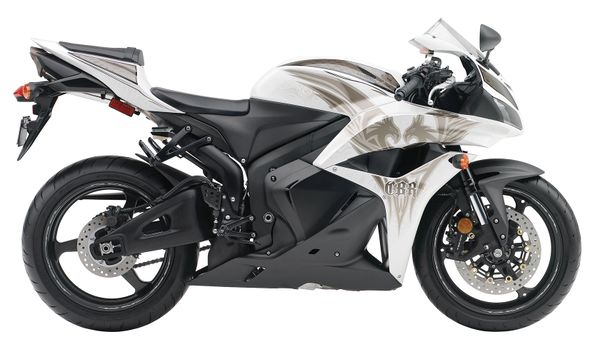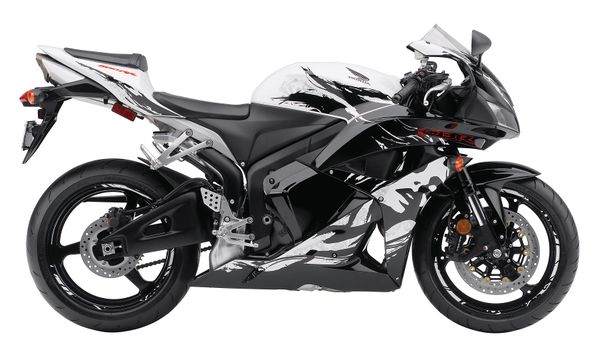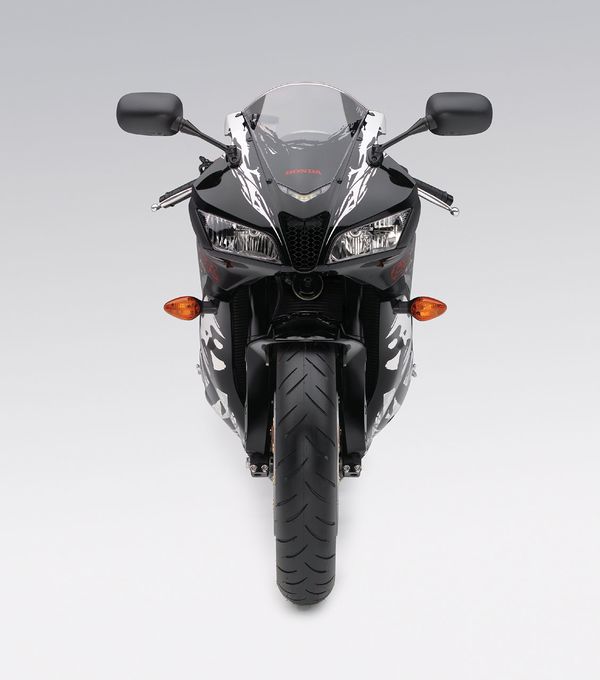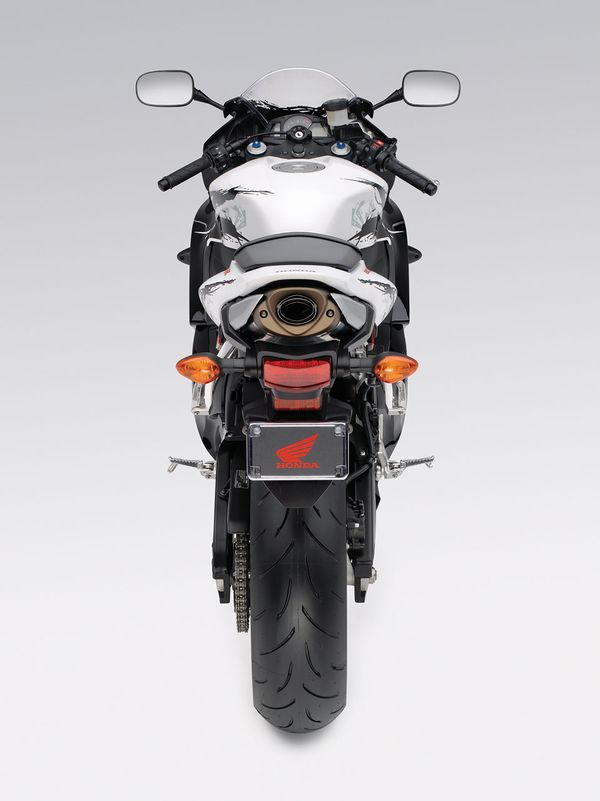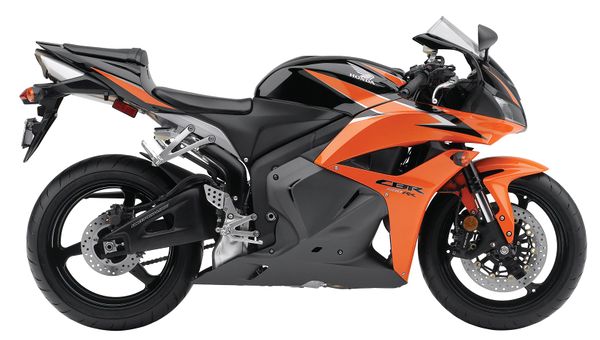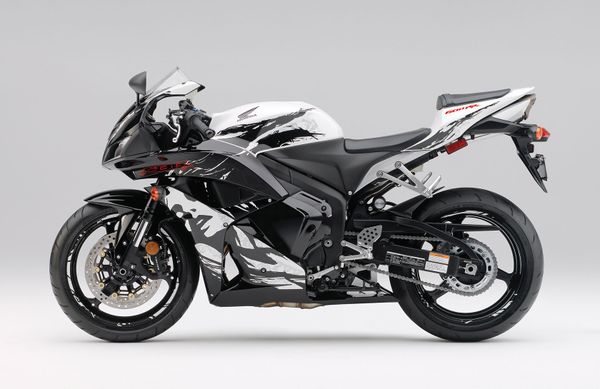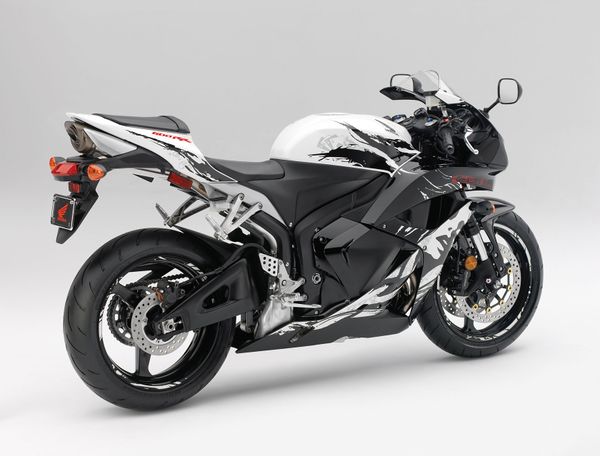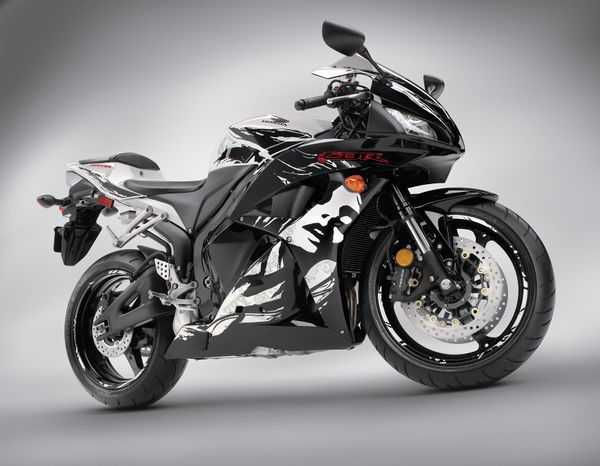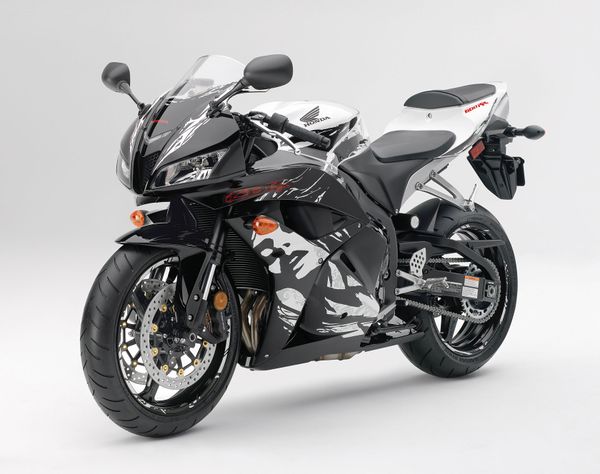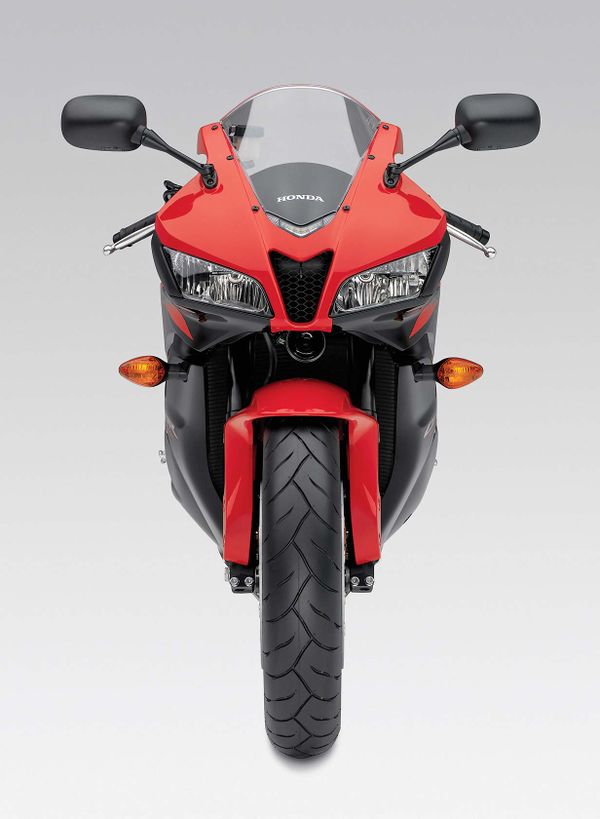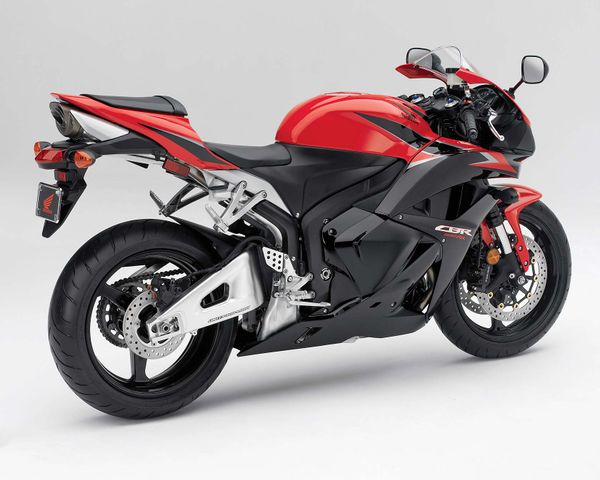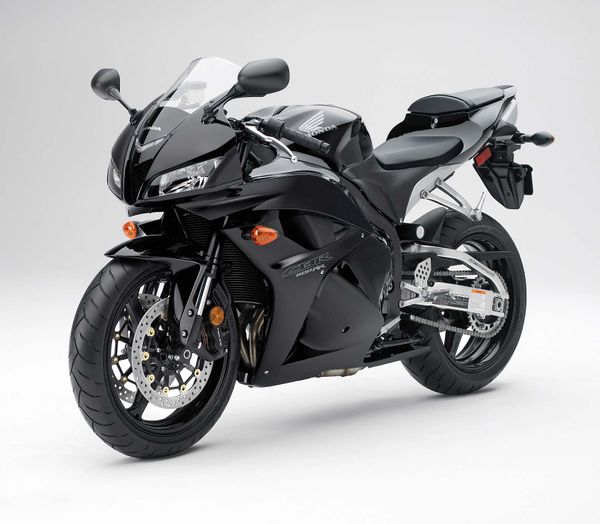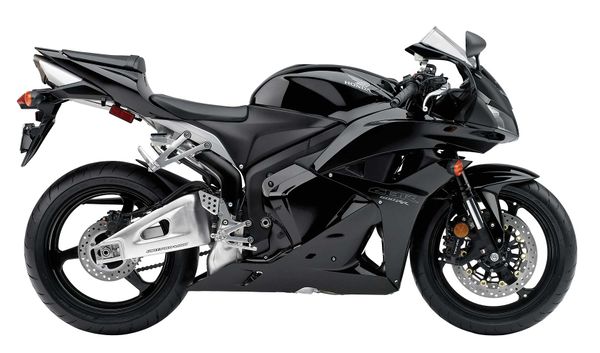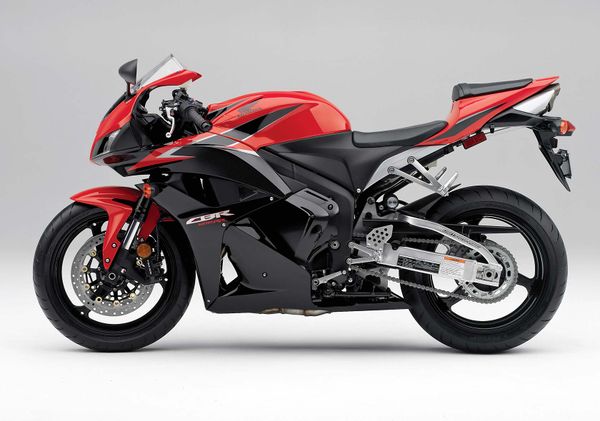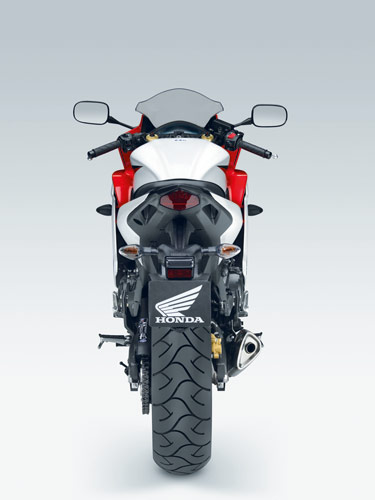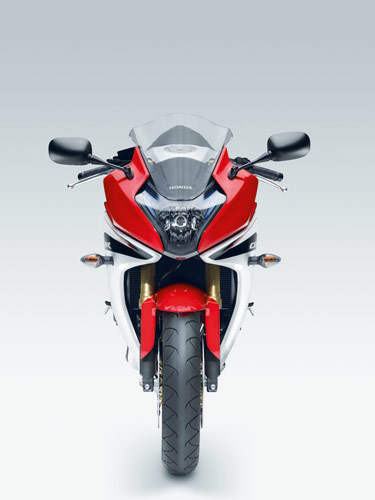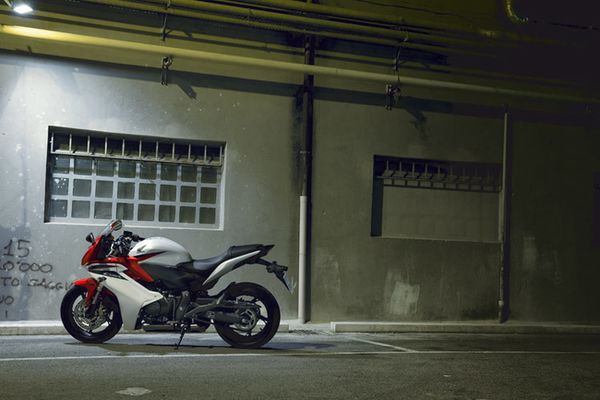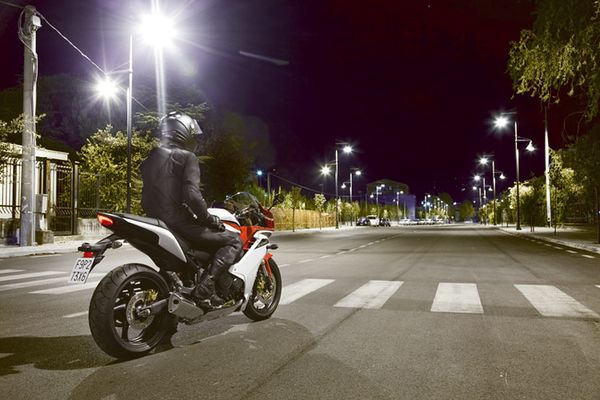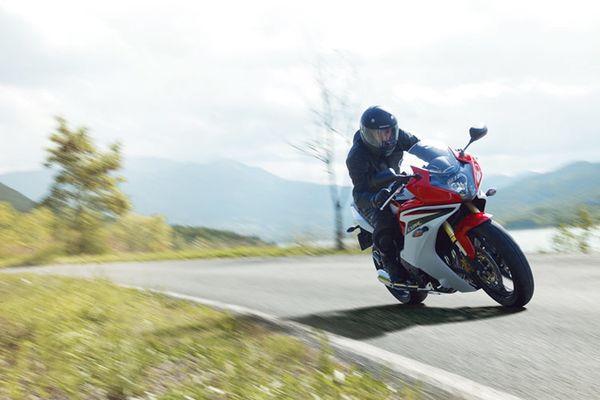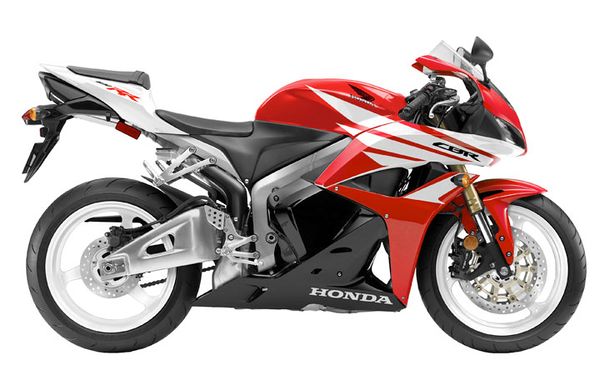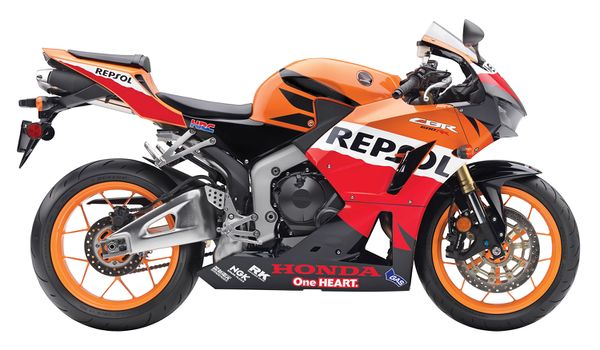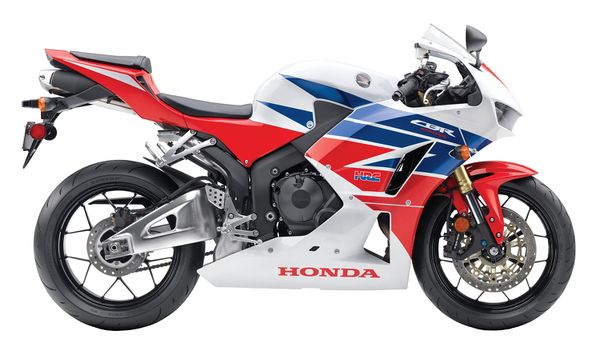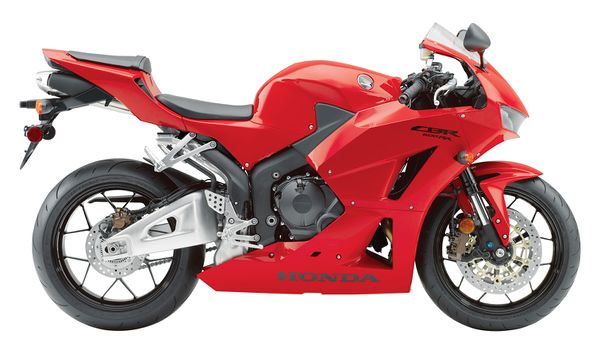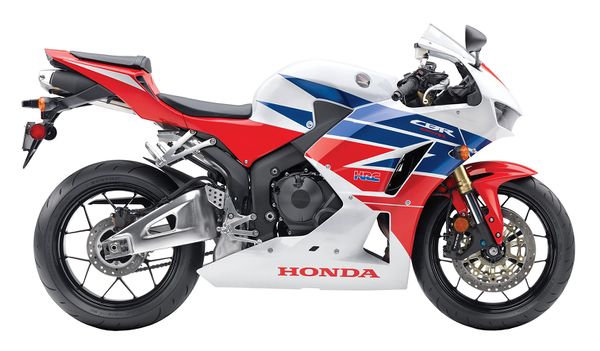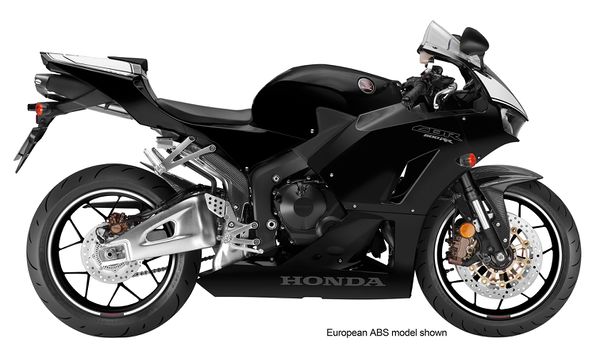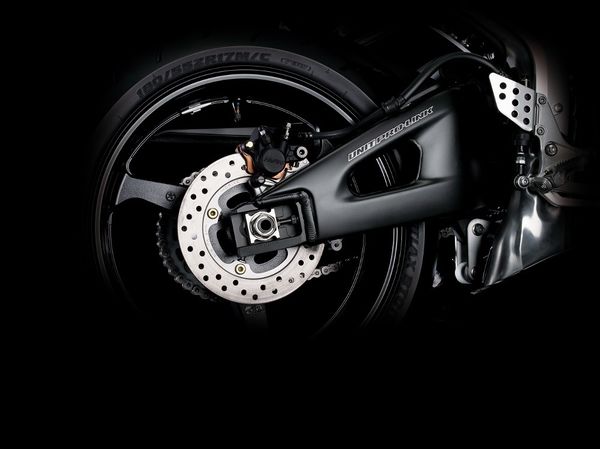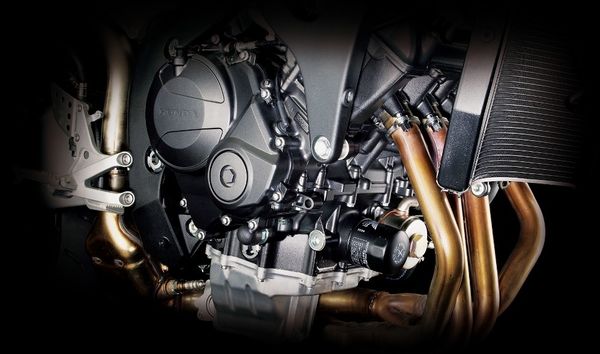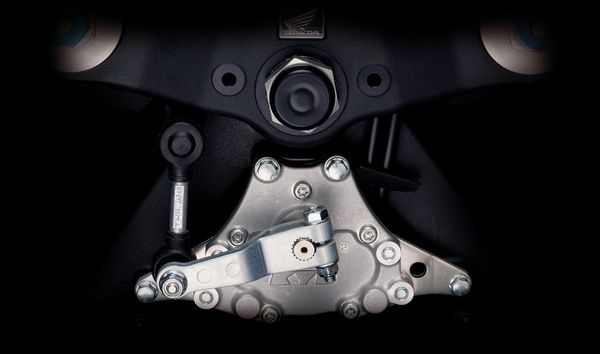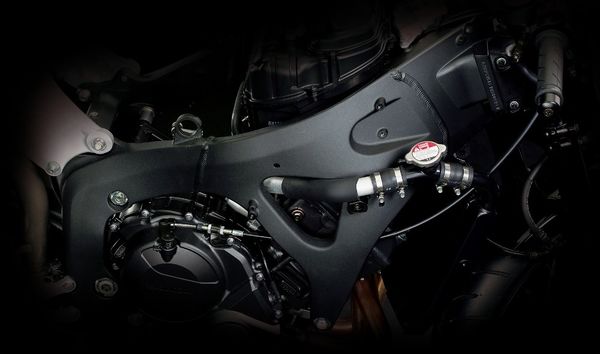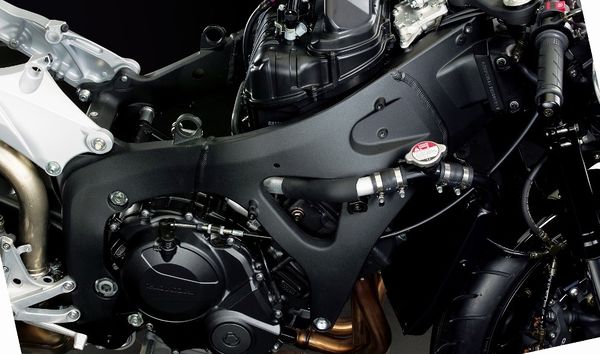Honda CBR600
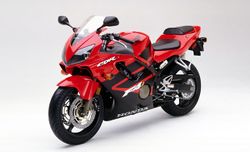 |
|
| Honda CBR600 | |
| Manufacturer | |
|---|---|
| Also called | CBR600F (reduced effect), CBR 600 F (reduced effect), CBR600F Ultima Light, CBR 600 F Ultima Light, CBR600F Sport, CBR 600 F Sport, CBR600RR Movistar, CBR 600 RR Movistar, CBR600RR HANNspree Ten Kate Replica, CBR 600 RR HANNspree Ten Kate Replica, CBR600RR ABS, CBR600RR, CBR600 F4i, CBR600FS, CBR600F3, CBR600F4, CBR600F, CBR 600 RR, CBR 600 FS, CBR 600 F4i, CBR 600 F4, CBR 600 F3, CBR 600 F, CBR 600 |
| Production | 1987 - 2019 |
| Class | Sport Bike |
| Engine | in-line four, four-stroke |
| Bore / Stroke | 67.0mm x 42.5mm |
| Compression ratio | 12.2:1 |
| Top Speed | 155 mph (250 km/h) |
| Horsepower | 117.47 HP (87.6 KW) @ 13500RPM |
| Torque | 48.68 ft/lbs (66.0 Nm) @ 11225RPM |
| Fuel System | injection. dual stage fuel injection (dsfi) with 40mm throttle bodies, denso 12-hole injectors |
| Ignition | computer-controlled digital transistorized with 3-d mapping |
| Transmission | Gear box: 6-speed Final Drive: chain |
| Suspension | Front: 41mm inverted big piston fork with spring preload, rebound and compression damping adjustability Rear: unit pro-link hmas single shock with spring preload, rebound and compression damping adjustability |
| Brakes | Front: double disc. dual radial-mounted four-piston calipers with full-floating Rear: single disc. single-piston caliper. |
| Front Tire | 120/70-zr17 |
| Rear Tire | 180/55-zr17 |
| Wheelbase | 53.9 inches (1369 mm) |
| Length | 79.88 inches (2029 mm) |
| Width | 26.97 inches (685 mm) |
| Height | 43.9 inches (1115 mm) |
| Seat Height | 32.28 inches (820 mm) |
| Weight | 683.43 pounds (310.0 Kg) (dry), 186.0 kg (wet) |
| Recommended Oil | Honda GN4 10W-40 |
| Fuel Capacity | 4.8 Gallon (18.17 Liters) |
| Fuel Consumption | 5.35 liters/100 km (18.7 km/l or 43.97 mpg) |
| Manuals | Service Manual |
The Honda CBR600RR was a in-line four, four-stroke Sport Bike motorcycle produced by Honda between 1987 and 2019. It could reach a top speed of 155 mph (250 km/h). Max torque was 48.68 ft/lbs (66.0 Nm) @ 11225 RPM. Claimed horsepower was 117.47 HP (87.6 KW) @ 13500 RPM.
Engine[edit | edit source]
The engine was a liquid cooled in-line four, four-stroke. A 67.0mm bore x 42.5mm stroke result in a displacement of just 599.0 cubic centimeters. Fuel was supplied via a double overhead cams/twin cam (dohc).
Drive[edit | edit source]
The bike has a 6-speed transmission. Power was moderated via the Wet multi-plate.
Chassis[edit | edit source]
It came with a 120/70-zr17 front tire and a 180/55-zr17 rear tire. Stopping was achieved via double disc. dual radial-mounted four-piston calipers with full-floating in the front and a single disc. single-piston caliper. in the rear. The front suspension was a 41mm inverted big piston fork with spring preload, rebound and compression damping adjustability while the rear was equipped with a unit pro-link hmas single shock with spring preload, rebound and compression damping adjustability. The CBR600RR was fitted with a 4.8 Gallon (18.17 Liters) fuel tank. The bike weighed just 683.43 pounds (310.0 Kg). The wheelbase was 53.9 inches (1369 mm) long.
1990 Honda CBR 600 F[edit | edit source]
The CBR 600F is the first member of the CBR600 series, being equipped with a liquid cooled, four stroke, 598cc engine which develops 93 horsepower at 11000rpm.
1995 - 1998 Honda CBR 600 F3[edit | edit source]
Following the success of the F2 motorcycle, the Japanese company Honda decided to bring up a brand new model called F3. The F3 sport bike has one more kg than the previous model and it can even run with 15 km/h faster than it.
2001 Honda CBR600 F4i[edit | edit source]
The 2000 CBR600 F4i receives 5% more peak power and multiple engine revisions for enhanced reliability under hard stress conditions. Ont he functional side, some of the bodywork parts are also redesigned to become lighter, while aesthetic changes are also making the bike look more aggressive.
With a larger tank, riding outside the city and at the track is now more rewarding and will need less refueling, allowing motorcyclists to enjoy more time on two wheels. One of the reference supersport bikes, Honda's 2000 iteration of the CBR600 F4i is ready for some hard riding-action.
2002 Honda CBR600 F4i[edit | edit source]
Derived from a bike engineered to win races, the 2001 Honda CBR600 F4i received a nifty makeover which added enhanced streetability. Still a sporty, rev-eager machine, the CBR600 F4i now delivers better comfort, predictable power delivery and excellent maneuverability for the busy urban traffic.
Built with a Pro Frame chassis and HMAS adjustable suspensions, hollow aluminum wheels and easy-to-service bodywork, the 2001 CBR600 F4i is a great way to enjoy supersport performance at street level.
2003 Honda CBR600RR[edit | edit source]
The 2002 CBR600R is a supersport machine massively inspired from the RC211V MotoGP winner bike. It embeds a lot of GP-derived technologies which help it deliver stunning performance on the track.
However, Honda made redesigned the racing beast and added a lot more usability on casual streets. 2002 brings a new exhaust and an all-new 16-valve engine, mounted in an all-new frame with race-grade key components.
2003 Honda CBR600 F4i[edit | edit source]
Built to win races, but modified for real-world comfort, the 2002 CBR600 F4i is a streetable high-performance machine which provides the classic suspersport grunt and daily usability around the city. While the looks of the bike allow no mistaking it for anything else than a real sport machine, ergonomics are enhanced, and with specially-tuned suspensions, handling is kept to the max.
With all its character and road stance, the CBR600 F4i is one of the benchmarks in the supersport class.
2004 Honda CBR600RR[edit | edit source]
It's the same RC211V MotoGP machine which inspired the 2003 Honda CBR600RR, and the results were soon delivered: this supersport bike delivered multiple victories in most of the series it entered, proving that prototype-bred motorcycles are indeed superior.
With some revamping and the addition of MotoGP-derived suspensions, the 2003 CBR600RR is ready to race out of the crate. Still, Honda made some revisions to make the bike a tad more comfortable on the street, as it was obvious that many customers were not that willing to leave riding it for the weekends, solely.
2004 Honda CBR600 F4i[edit | edit source]
The 2003 CBR600 F4i is the more street-oriented version of Honda's Supersport-class machine, a fast, powerful and very agile machine which can be used as both urban commuter and track-focused beast.
With updated ergonomics, the CBR600 F4i can even receive a luggage system and become a nifty sport-touring machine, if no proper touring bike is at hand. Sharing some components with its more racey siblings, the 2003 CBR600 F4i delivers the same acclaimed, uncompromised performance Honda has been renowned for since a long time ago.
2004 Honda CBR 600 RR[edit | edit source]
Honda's CBR600RR, a super sport motorcycle created in 2003, could be seen in multiple colors, including white, black, blue and silver.
2005 Honda CBR600 F4i[edit | edit source]
The 2004 CBR600 F4i is a great way for Honda to show its abilities of creating exceptional bikes. This machine is a successful combination between full-on sport motorcycles and bikes with good day-long rideability, being a good choice on the track and an equally usable daily commuter.
Offering plenty of power in a lightweight package, the 2003 CBR600 F4i is loaded with a lot of parts and technologies derived from Honda's racing programs, from suspension elements to the fuel injection and down to more subtle elements such as cylinder coating. A sport bike in road trim, the CBR600 F4i is a great way to enjoy streetable supersport machines.
2005 Honda CBR600RR[edit | edit source]
The 2004 CBR600RR receives a lot of upgrades, and we could say we're dealing with an almost entirely new motorcycle. This supersport machine got new radial brakes, a 41mm USD forkm new piston treatment and a new intake design, better injection, and a redesigned frame, including the swingarm, rear shock and upper triple clamp.
At the same time, the bodywork also got revisions to bring it closer to he RC211V. with an underseat exhaust and centralized fuel tank for better mass distribution.
2006 Honda CBR600RR[edit | edit source]
The 2005 Honda CBR600RR is the street-legal derivation of the supersport machines which dominate the tacks around the world. Based on the track-only machines, this bike retains many of the technologies used in those top-notch models, such as dual-stage injection, RC211V-style underseat exhaust, the Unit Pro-Link rear suspension and the high rev limit.
At the same time, the bike comes with radial calipers, a centrally-mounted fuel tank and the unmistakeable RC211V-derived bodywork, openly declaring its racey heritage.
2006 Honda CBR600 F4i[edit | edit source]
The 2005 CBR600 F4i boasts a most convenient balance between the full-on sport bike engineered for track use and the daily rideability of a commuter motorcycle. Derived from Honda's successful supersport program, the CBR600 F4i sports many features which make is a fast machine which is fun to ride hard. Still ergonomics and geometry have been revised to make spending log hours on it less of a grueling task.
With a Pro Frame chassis and suspensions tuned for both track and city use, the 2005 CBR600 F4i can also be transformed into a sport-touring machine with the addition of a luggage system.
2006 Honda CBR 600 RR[edit | edit source]
In 2005, the CBR600RR received its first major revision with new bodywork, fully adjustable inverted front forks, race-inspired disc brakes with radial-mounted four-piston calipers, and an entirely new aluminum frame, swingarm and rear shock. There was also an increase in the midrange power. The model's wet weight was brought down by 22 lbs (10 kg), and dry weight by 9 lbs (4.1 kg). In 2006, the CBR 600 RR received new color schemes.
2008 Honda CBR600RR[edit | edit source]
Compact, powerful and most capable to deliver an exhilarating riding experience, the 2007 Honda CBR600RR is loaded with technology developed for Honda's racing programs. Riders can enjoy the Dual Stage fuel injection, the state-of-the art Pro-Link rear suspension, HESD electronic steering damper and many more features which are engineered to provide top-performance and great fun on both street and track.
One of the the middleweight class benchmarks, the Honda CBR600RR can also serve as a daily commuting machine, provided you don't mind spending some time in a sporty riding position in the busy urban traffic.
2008 Honda CBR 600 RR[edit | edit source]
Honda's CBR600RR, a super sport motorcycle created in 2007, could be seen in multiple colors, including white, black, blue and silver.
2009 Honda CBR600RR ABS[edit | edit source]
Riders who want the ultimate in stability with their CBR600RR should be happy to learn that Honda added ABS to the 2008 model year. Available in the same package with Honda's acclaimed Combined Braking System, the ABS is supposed to deliver even better stopping performance, with the smart distribution of the braking power between the two wheels, reducing the side-effects of hard braking on difficult and slippery surfaces.
The 2008 Honda CBR600RR ABS has also received mid-range tuning for more power, better brakes in the shape of 4-pot monoblock radial calipers and an updated livery.
2009 Honda CBR 600 RR[edit | edit source]
In September 2008, after announcing the recently developed Combined ABS system, Honda announced the 2009 CBR 600 RR. This motorcycle got its major update back in 2007 but there have been several improvements brought to this bike for 2009, such as the C-ABS and a revised engine, with the pistons, cylinder head and exhaust tweaked to enhance mid-range torque between 8000 and 12000 rpm to a maximum of 3.5% more than the older models.
2009 Honda CBR600RR[edit | edit source]
The Honda CBR600RR is on of the most popular supersport motorcycles in the worlds, and for good reasons. It packs radical yet manageable performance, derived straight from Honda's racing program and can put a smile on riders' faces both on the street and on the track. Light, compact and with very good high-speed handling, the CBR600RR can also be used for daily commuting.
The 2008 Honda CBR600RR brings an upgraded bodywork, increased mid-range power, lighter turning signals and radial monoblock 4-pot calipers for the front brake.
2010 Honda CBR600RR ABS[edit | edit source]
Loaded with all the goodies the base model CBR600RR proudly displays, the ABS version offers even more in terms of the sought-after safety and reassuring feel. Blending in Honda's patented combined braking system with the anti-lock brakes results in increased performance when having to slow down or stop really quick, while adding enhanced stability on difficult, wet surfaces.
As for the rest, the 2009 CBR600RR is the same bike, with surprisingly pleasant and precise handling, boasting enough power to cause a huge adrenaline rush to both new and seasoned riders.
2010 Honda CBR600RR[edit | edit source]
Honda shows one more model year for their amazing CBR600RR supersport machine, on of the benchmarks against which so many of competitors' bikes are measured against. A motorcycle which can deliver extreme performance in the hands of a skilled rider, the 2009 Honda CBR600RR is still fairly easy on the less experienced ones, capable of providing a reassuring, tamed experience, as well.
Sharing quite a lot of technology with its bigger, liter-class sister, the 2009 CBR600RR is ready to take on both streets and race track: premium suspensions, radial front calipers with beefy rotors, dual-stage injection with Denso 12-hole injectors and many more similar features make this machine a really wonderful piece of two-wheeled engineering.
2011 Honda CBR600RR ABS[edit | edit source]
Just like its very name makes it clear for everybody, this is the ABS version of the acclaimed 2010 Honda CBR600RR. Maxing out the safety features, this machine brings the proven, dependable Combined ABS brakes to the street game, adding serious brain-power to the stopping force of this sporty bike.
The C-ABS system distributes the braking force over both wheels, while electronics constantly balance it to provide the most efficient slowing down algorithm, while keeping bike stability to the maximum possible. Add this to the race-specced Unit Pro-Link rear suspension and HMAS forks to get the true image of what a real middleweight sport bike should be like.
2011 Honda CBR600RR[edit | edit source]
The 2010 Honda CBR600RR is a nifty mix of sporty performance, great city looks and maneuverability. One of the most popular middleweight sport bikes in the world, the CBR600RR manages to bring the best in all segments into one nifty package which can seemingly do a lot more than speed on a race track.
It can be ridden hard during track weekends, but it can also be used for commuting: it's compliant suspensions are tuned to deliver a smooth ride in the urban traffic, as well as on countryside roads. Sharing many of the technologies derived from the sport bikes, the 2010 Honda CBR600RR is indeed a scaled-down version of the racing beasts, only in a guise which allows even newer riders to enjoy it thoroughly.
2011 Honda CBR600F[edit | edit source]
While many two-wheeled fans have lost hope for a revival of the 'F', Honda decided to wow the crowds attending the EICMA show in Milan in 2010 by introducing an all-new middleweight sportsbike. The 2011 CBR600F came as a breath of fresh air, joining its smaller siblings in the manufacturer's revised CBR line-up: the all-new CBR125R and CBR250R.
So a new high performance road sportsbike was born, equipped with a compact alloy 599cc engine and Mono-Backbone aluminum frame as its starting point. The re-engineered CBR600F is praised for its neutral handling, near-Supersport levels of performance, as well as a high level of refinement and practicality.
2012 Honda CBR 600 RR[edit | edit source]
An iconic presence in the world of middleweight supersport machines, the Honda CBR600RR is a true winner. Sharing top-level technology inspired by the racing industry, the 2011 model is all about compact design and sporty feel. With ultra-centralized mass and lightweight components, the 2011 CBR600RR offers modern, radial-mounted calipers for a more reassuring braking feel, even under hard conditions.
With a revised bodywork providing better aerodynamics, the 2011 Honda CBR600RR is now even more suitable for weekends at the race track, but still it makes a nifty sporty all-rounder bike which can be used for middle-distance daily commuting. Updated suspensions offer better grip under extreme conditions, for more agility in traffic or on the track.
2013 Honda CBR600RR[edit | edit source]
An on-track winner on so many occasions, the Honda CBR600RR is the streetable version dedicated to those who want to expand the adrenaline-filled experience to everyday riding. Sporty, nimble and more comfortable than the racing version, the 2012 CBR600RR comes with numerous upgrades.
The bike now has a Showa Big Piston Fork, a redesigned, centrally-mounted ram-air intake, a revised rear suspension, upgraded aerodynamics, and is also available in the iconic Repsol livery.
2014 Honda CBR600RR[edit | edit source]
The 2013 CBR600RR is all about Supersport-class high-performance machines combined with an extra dash of rider comfort and thus delivering a more street-worthy experience. Since it's an RR you can of course expect Honda's Electronic Steering Damper to be present, enhancing the tracking precision. The race-derived HMAS inverted fork is also standard, with radial mount calipers, MotoGP-developed Unit Pro-Link rear suspension and a centrally-located fuel tank for more agility through fast bends.
2014 Honda CBR600RR ABS[edit | edit source]
For both track or street, Honda offers the CBR600RR fans the choice to add more safety to their rides, thanks to the ABS. Even more, the anti-locking braking system is integrated with the existing CBS one which distributes the stopping force between the two axles, when only a lever is engaged.
Lightweight and exceptionally agile, the 2013 CBR600RR ABS is great for daily rides, as well, this bike comes with improved comfort. And with the redline at 15,000 rpm, you can tell this bike is no joke...
2016 Honda CBR600RR[edit | edit source]
The CBR600RR is a perfect example of typical Honda industry-leading innovation. Combining tons of power, refined, responsive handling and light weight with amazing styling, it’s equally at home carving your favorite canyon as it is collecting wins on World Supersport podiums. That’s the CBR600RR—the ultimate middleweight sportbike experience.
2017 Honda CBR600RR ABS[edit | edit source]
The CBR600RR was left out for 2017 when it comes to changes that Honda was throwing at their RR Super Sport bikes. The 2017 CBR1000RR and CBR250RR were the models that went under the knife this year with loads of changes. It is powered by a 599 cc, inline 4 engine producing 113 HP (84 Kw) at 13500 rpm and 66 Nm (48.7) at 11250 rpm.
2017 Honda CBR600RR[edit | edit source]
Honda CBR600RR has a 599cc, Liquid-cooled In-line 4-cylinder, 16-valve, DOHC, Dual-stage Fuel Injection with 40mm throttle bodies and Denso 12-hole injectors, computer-controlled ignition and digital transistorized with 3-D mapping, engine with a bore and stroke of 67mm and 42.5mm respectively.
In Media[edit | edit source]
- Camaleones
- Steps: Stomp
- Long Way Round
- Les bleus: premiers pas dans la police
- Milena Vucic: Celebrity
- Veronica Mars
- Undercover Brother
- NYPD Blue
- Policías, en el corazón de la calle
- Dos Hogares
- Take the 10
- Min søsters børn vælter Nordjylland
- Ellas aman, ellos mienten
- Street Crimes
- Circuitry Man
- Spawn
- Trial & Retribution
- Coogan's Run
- Periodistas
- Hospital Central
- Sons of Anarchy
- Murder, She Wrote
- 36 China Town
- Sep
- The Commish
- 099 Central
- Dancehall Queen
- Bratany
- Anti-Social
- Arrayán
- Debora: Tvoya
- Despido procedente
- Io non mi arrendo
- Tutti i santi giorni
- Krasnyy zhemchug lyubvi
- SOKO Leipzig
- Lovejoy
- Dhoom
- Dou hap
- Cemetery Man
- Inferno
- Le comiche 2
- C.L.A. No somos ángeles
- Diego Torres: Penélope
- El síndrome de Ulises
- Cenizas del paraíso
- Dead Rising
- La caja 507
- Midsomer Murders
- The Open Door
- Clocking Off
- Afghan Knights
- Los Protegidos
- The Girl from the Song
- Mañana es para siempre
- The Sentinel
- Small Soldiers
- The Fast and the Furious
- Familie Dr. Kleist
- Boris Dali: Ti reshi
- Louie
- Somewhere Between
- Unsolved
- Odessit
- Catacombs
- Collateral Damage
- 2 Fast 2 Real I
- LI Extreme
- How to Deal
- Biker Boyz
- Aşk ve ceza
- Exit Speed
- L'appât
- Heist
- The Blacklist
- Parking Wars
- Person of Interest
- Pyos
- 2 Fast 2 Real II
- Fifth Gear
- Crossover
- Las Vegas
- Ti stramo
- Reaper
- Antisnayper 2. Dvoynaya motivatsiya
- Sanctuary
- Cribs
- Smeshannye chuvstva
- Romanzo Siciliano
- Return to Insanity
- Kryminalni
- Camaleona
- Top Gear
- War
- Prince
- Tere Liye: Prince
- Duska
- Força-Tarefa
- Amores verdaderos
- King & Maxwell
- Hasta el fin del mundo
- Rozygrysh
- Hawaii Five-0
- Kommissarie Späck
- Fina Estampa
- Contract Killers
- Pod prikrytiem
- Tyga: Rap $tar
